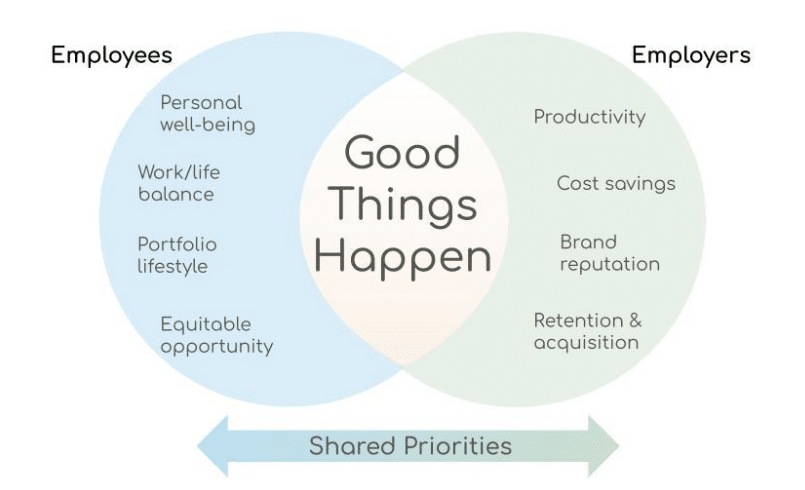“Must be nice…” As a job share team at Google, each working part-time, we were used to comments like this from colleagues. Never mind that we were successfully operating in a full-time role and making a significant trade-off in pay to make this flexible arrangement work.
These types of microaggressions were woven into the cultural fabric of a company – and an era – that valued “butts in seats” and “visible busy-ness” as much, if not more, than producing great work.
In a post-pandemic world, things are starting to look a bit different. The modern workplace is transforming and the balance of power is shifting. Employees are demanding flexibility, and employers are finally answering. With Covid as a trial run, many companies have now adopted a hybrid work model. Today, 74% of U.S. companies are currently using or plan to implement a permanent hybrid work model.
While this is undoubtedly progress, hybrid work only solves part of the flexibility equation. In fact, for this evolving workforce, the “when” and the “how” work gets done is arguably more meaningful. Future Forum’s quarterly Pulse survey of more than 10,000 knowledge workers across six countries found that while location flexibility is important — with 79% of workers saying they want flexibility in where they work — schedule flexibility is even more important — with a whopping 94% of workers saying they want more control over their schedule.
True workplace flexibility embraces the idea that employees can be productive no matter where – or when – they perform their work. Rather than enforcing a rigid schedule or environment, a holistic flexibility strategy acknowledges that there is no “one size fits all” solution for the diverse needs of employees. And the good news is that employers don’t have to sacrifice their own priorities or success to meet this new demand. Flexible work can underpin the collective priorities of both employees and employers, as illustrated in the value equation below:

So how do you bring a flexibility program to life? Building the cultural infrastructure to successfully support flexible work is a top-down, bottom-up, peer-to-peer endeavor that requires a shift in established work norms – from “being seen” to truly embodying a results-oriented work environment. This type of transformation won’t happen overnight, but making the commitment and creating a strong foundation now will set you up for success down the road.
Here are some practical steps that will help you get started in developing and sustaining a flexible work culture for your organization:
1. Understand and listen to your workforce: Who are they (demographics, psychographics, etc.) and what do they care about? Give employees a voice through 360 surveys, town halls, and/or affinity groups.
2. Define / refine a flexibility purpose: What is the value of adopting flexibility for your business? How does it align with your organization’s overall mission and purpose?
3. Bring in stakeholders and establish sponsorship / ownership: Stakeholders can ensure that the right policies and guidelines are cemented, thereby avoiding “crash and burn” scenarios that fail to embed flexibility programs into the culture of your organization.
4. Test ahead of significant investment or commitment: Testing is lower risk, lower fidelity, and much cheaper than making a broad sweeping change to people programs.
- Ideas for trial flexibility programs:
Identify and test potential solutions that align with your unique organizational challenges or needs; make informed, data-driven decisions about how to move forward.
-
- Pilot 1-2 time-bound job share* teams to get a sense of value and organizational impact, as well as which areas of the org would benefit most from this model.
- Pilot a 4-day work week (32 hours) over one time-bound period; i.e. summer. (Multiple recent large-scale reduced-hour trials across the globe have proven highly successful.)**
5. Evaluate training needs for employees, teams, managers & organizational leaders: enhance and/or develop flexibility training curriculum to advance the shift from historical norms and infuse flexibility values into your cultural DNA.
- Ideas for flexibility training:
Develop or outsource workshops for managers/leaders or full-teams around equitable work and the idea that one size doesn’t fit all (this might live within inclusivity work already underway).
Topics could include:
-
- Eliminating bias & micro-aggressions
- Championing a results oriented work environment
- Team set-up, meeting standards, and communication norms
- Recruiting with flexibility in mind (job postings include flexibility options)
- Restructuring performance reviews
6. Build for the long term:
- Define and document clear policies and guidelines for flexible work; ensure consistency and accessibility.
- Determine criteria for employee participation (tenure, perf rating minimums, etc.)
- Identify and deploy ongoing training, particularly for managers, to sustain a flexibility program / specific flexible work models.
- Evaluate your performance review process for inclusivity of all flexible work arrangements; clearly assess and outline what flexible employees need to be successful.
The future of work is flexible. People are demanding flexibility in when, where, and how they work and employers cannot afford to bury their heads in the sand. While change can be scary, the potential risks of inaction are even scarier: Loss or alienation of existing talent, inability to attract new talent, decreased diversity, productivity drag, and culture erosion. With the right strategy, investment, activation – and a little imagination – building a successful and sustainable flexible work program into your organization is possible. We’re living proof that flexible work can not only “work” but can empower people to do their best work.
References:
*Job-sharing is a highly effective but underutilized flexibility solution in which two professionals with mutually relevant experience and a complementary skill set each work part-time to fulfill one full-time role.
**Four day work week trial research, 4 Day Week Global, 2023
This post was written by Sara Wiita and Shannon Crile from ChapterTwo Group.














